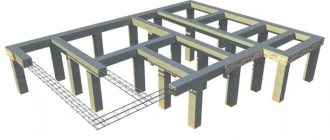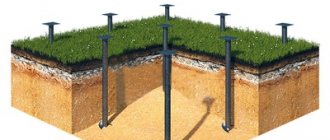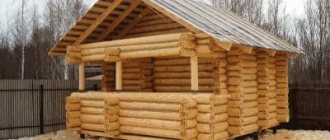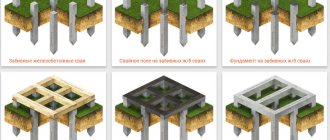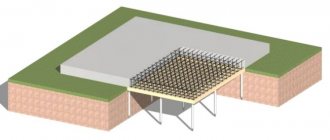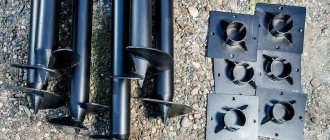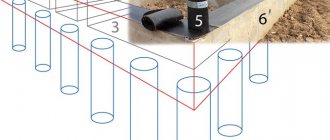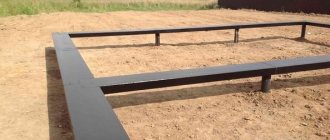The quality of the soil has a great influence on the choice of foundation and the entire construction technology in general.
In Russia there are a large number of problem regions where swampy, flooded or weak-bearing soil types predominate.
The use of a traditional foundation in such conditions is unacceptable, but pile types of support structures come to the rescue.
They ensure contact of the base with dense layers of soil and allow the construction of massive and heavy buildings without fear for their condition.
There are also lighter options for pile foundations, which include screw piles.
Foundation on screw piles
Screw piles are a supporting structure in the form of a system of metal pipes immersed in the ground with spiral blades welded at the bottom (photo below) . They play the role of cutting, similar to that done on screws.
The pointed conical tip allows the trunk to enter the ground more easily, and the blades perform the cutting function and in parallel serve as support units.
The submerged support is kept stationary due to the frictional force between the side walls of the pipe and the ground, as well as due to the load on the blades. The installation is carried out according to a certain scheme, forming the so-called. a pile field that ensures uniform load distribution across all shafts .
After immersion, the upper parts are trimmed to form a flat plane and tied with a load-bearing belt - a grillage.
It provides a supporting structure for the walls and evenly transfers the load to the pile system.
The functions of the grillage are close to the operation of a strip foundation, but the support for it is not the ground surface, but the upper ends of the vertical rods. To strengthen the structure, hollow pipes are filled with compacted concrete after installation, which makes them immune to possible lateral loads .
IMPORTANT!
Installation of screw piles does not require immersion until contact with dense layers of soil occurs. With sufficient depth, they quite reliably hold the building, being a hanging type of piles.
Advantages and disadvantages
The advantages of screw piles include:
- High installation speed.
- Possibility of manual installation, which allows you to work in close proximity to finished buildings.
- The cost of screw piles is much lower than other types of foundation.
- Possibility of reuse. If necessary, the piles can be removed and used elsewhere.
- No excavation required for installation.
- It is possible to build on slopes or folds of the terrain.
- You can do without the use of complex equipment.
The disadvantages are:
- Operating conditions promote corrosion.
- The use of screw piles in regions with high seismic activity is prohibited.
- Immersion in rocky soil is not permitted.
- The use of screw piles on loose or weak-bearing soils that do not provide sufficient lateral support requires additional examination and clarification of the immersion depth.
Most of the shortcomings are often hushed up by manufacturers, so it is necessary to have a complete understanding of the properties and qualities of the design.
Types of supports
Let's consider what types of screw supports are used in modern construction:
By area of application
This type of foundation is used much more widely than it might seem at first glance.
Screw piles are successfully used in the following areas:
- Capital construction.
- Individual residential construction.
- Bridges, piers, other hydraulic structures.
- Load-bearing supports of power lines, masts, etc.
- Hangars.
- Greenhouses.
- Fences or enclosures, etc.
The rise in popularity of this type of base has greatly expanded the range of applications, and the process is not over yet..
Dimensions
Steel pipes of different diameters are used . The most common pipes are 108 mm; this size provides a fairly high load-bearing capacity with good penetration into the ground.
The general range of pipe diameters is between 57-219 mm, but in some cases thicker supports are used .
In private housing construction, pipes larger than 159 mm are not used due to the difficulty of immersion.
The length of the pipes also has many options . There are standard sizes from 1650 to 9000 mm, used in appropriate conditions.
The lower the strength and density of the soil, the longer the trunk should be.
Number of blades
There are single and multi-bladed designs. Single blades are used on relatively stable soils.
Exceeding the load or reversing the pile during installation leads to loss of adhesion to the ground.
For critical buildings on weak-bearing soils, multi-bladed piles are used, which demonstrate greater resistance to possible loads.
In addition, increasing the number of blades allows you to reduce the diameter of the barrel, which makes diving easier.
At the same time, the thickness of the walls must provide the necessary rigidity.
Tips
The tip takes on the load when immersed, which puts forward quite stringent requirements for its design.
Exist:
- Welded tips . They are made by narrowing the diameter of the pipe by removing wedge-shaped sections and connecting the resulting fragments into a cone. The seams are welded and a pointed end is formed. Used for relatively weak, soft soils.
- Cast tips . They are manufactured (cast) separately and attached to the pipe. They are thick and capable of destroying obstacles. Used on dense and difficult soils.
Material of manufacture
Different grades of steel are used - from the usual St 3 to the more durable St 20.
For use in highly aggressive soils with heavy loads and the possibility of electrostatic corrosion, durable steel grades 30 KhMA and 09G2S are used.
Type of protective coating
The most effective coating is considered to be a layer of zinc. At the same time, the material itself must be sufficiently resistant to corrosion .
Polymer materials applied to the piles are erased during immersion and cannot fulfill their task.
They are necessary only to protect the outer part of the supports and require periodic updating.
Many engineers offer their own protection options, from mastics to applying a layer of rubber, but these methods have not yet become widespread.
Disadvantages of a pile-screw foundation
Pile-screw foundations also have certain disadvantages that are worth studying before deciding to install them:
– 1. Rapid failure when installed in soils with high humidity, acidity or alkalinity . If the chemical reaction of the soil differs significantly from neutral, screw piles usually last no longer than 50-60 years.
In difficult conditions, piles are susceptible to corrosion, losing their service life.
– 2. The load-bearing capacity of a pile-screw foundation is significantly limited : capital construction of multi-story buildings on it is unacceptable.
– 3. Impossibility to arrange a basement , since the contact of the piles with the soil is disrupted during such attempts.
– 4. Groundwater entering the subfloor of a building can cause serious damage to the foundation , so careful waterproofing of the blind areas and the basement is necessary.
– 5. The project of a pile-screw foundation is expensive because it is strictly individual. It takes into account the geological features of the site and makes very labor-intensive calculations.
The project is not always done, but if you have a fairly complex area, you cannot do without it.
– 6. Impossibility of installing such a foundation in rocky soil : the piles simply cannot be buried to a sufficient depth.
– 7. Poor quality materials . Screw piles purchased from unscrupulous companies will provide poor support for even the lightest structure and will require replacement within a few months.
Which ones are most optimal for use in country house construction?
It is impossible to name the optimal type of screw piles without analyzing the soil or calculating the weight of the house.
If we proceed from the specifics of the construction, which involves the creation of a relatively light house with a small number of floors, then the most appropriate option would be to use single-bladed trunks with a diameter of 57 to 108 mm, depending on the type and condition of the soil .
More detailed information will only be provided by surveying the site and calculating the load, since the pile has a certain limit. For example, with a diameter of 57 mm, the maximum load will be 800 kg .
Application area
Initially, pile-screw foundations were used in the construction of piers. But the military developed this idea, significantly expanding the scope of use. And today this type of foundation is widely used in private construction. The production technology of screw piles has been significantly improved - special high-strength steel is used to create them. In addition, some piles have special blades on the head, which allow additional compaction of the soil layer adjacent to them.
Therefore, this type of foundation can be a good choice when building in difficult areas. This can include:
- areas with slopes, hills, depressions;
- areas with heaving soil;
- peat areas;
- regions with deep soil freezing.
Conducting construction on all these sites and using traditional types of foundations (monolithic, columnar or strip) is quite problematic. In addition, even with proper installation, in such areas an ordinary foundation can be destroyed within a few years - due to seasonal changes in groundwater, as well as soil freezing. But a pile-screw foundation can easily last in such circumstances for several years.
For what buildings is it needed?
Screw piles can be used for various buildings. World practice has shown the ability of this type of foundation to successfully work with massive, heavy and tall buildings and structures.
However, in Russia the technology for creating this foundation has not yet been developed, so they are usually limited to the construction of auxiliary or outbuildings. For residential buildings, screw piles are used reluctantly and quite rarely.
Life time
Under ideal conditions (soil that does not have a destructive effect on the material, no corrosion, etc.), the support can last up to 300 years , and if there is a galvanized layer, up to 800 years.
This is what manufacturers and marketers say, although they have no basis for this. Not even 299 years have passed since the invention, so such statements cannot be taken seriously. Ideal conditions do not exist, and impacts and normal metal fatigue have not gone away .
Therefore, the real service life of such a foundation should be considered 50-75 years, although deviations in one direction or another are possible.
NOTE!
Some of the structures that were first built on screw piles by their inventor, Mitchell, are still standing and in use today.
Flaws
Along with the advantages of a foundation on screw piles, there are always disadvantages and limitations that need to be taken into account before starting construction.
The disadvantages of metal supports that are screwed into the ground include the following factors:
Not used for the construction of permanent multi-storey structures. This is primarily due to the fact that the installed piles are in no way connected to each other and are exposed to varying degrees by the influence of the soil.
Uneven shrinkage of the foundation does not lead to the formation of cracks and deformations in the walls of wooden houses, which cannot be said about brick and concrete structures.- Not suitable for all soils . The supports are not recommended for use in areas with rocky soil, a high content of stone layers and limestone deposits.
- Difficulties in constructing basements . When using screw piles, you can build a basement, but it will be a separate structure with its own walls. This option will lead to an increase in the cost of construction as a whole.
- Low quality metal . Many pile manufacturers skimp on the quality of metal and anti-corrosion coating. This leads to premature rotting and destruction of the supports, as well as possible deformations during installation. If the soil contains a large amount of chemically aggressive substances, the service life of the pile is reduced to 50 years.
- Susceptibility to bending loads . In areas with moving soil, metal supports may become deformed during operation, which will generally weaken the entire structure.
Is this a capital foundation or not?
Screw-in piles are capable of supporting very heavy and massive buildings or structures. Therefore, they should be considered a capital foundation by right.
In this matter, a certain psychological imbalance arises, since outwardly they do not look like a reliable support corresponding to the term “capital”.
However, the main feature is the permissibility of use in the construction of residential buildings.
This allows us to reasonably consider screw piles as a permanent type of foundation.
How to make the right choice?
The selection of screw piles consists of two stages:
- Determining the appropriate size and type of screw piles.
- Selection of specific products based on quality and compliance with requirements.
The first stage is almost entirely carried out during the design of the house. Therefore, there is no point in talking about it.
The second stage is usually carried out by representatives of the company with which the contract is concluded.
If for some reason you have to choose on your own, you should pay attention to the following details:
- The thickness of the pipe walls should not be less than 4 mm.
- The thickness of the blades is at least 5 mm.
- The quality of welding must be as high as possible.
- The presence of a galvanized layer.
- Tip type and quality.
Using these criteria, you can choose the best quality products.
IMPORTANT!
If any items do not meet the established requirements, it is better to refuse to purchase such piles.
Owner reviews and typical mistakes during construction
Builders who undertake to build a foundation with their own hands, without qualifications and experience, often violate technology, which negatively affects the service life of the structure itself.
Mistakes that are most often made during the construction of a pile-screw foundation:
- Refusal from concreting the internal cavity of the pile. If the support wall thickness is less than 4 mm, then the metal may tear during service as a result of severe freezing of the soil. Therefore, the inside of the pile must be completely filled with solution, preventing the development of internal corrosion. The reinforced structure will also provide the necessary rigidity to the foundation.
- Piles at different depths. This occurs due to the heterogeneity of the soil in the area. As a result, the uniformity of the bearing capacity of the foundation is disrupted. To avoid this, the piles are screwed all the way into solid ground.
- Deviation from the vertical plane. In the process of deepening a metal pillar, builders may stumble upon underground obstacles and the axis of the pile will shift to the side. The permissible deviation should not exceed 2 degrees, otherwise the stability of the structure will be impaired.
Shortcomings in pre-design calculations can lead to house swaying and other troubles. The reason for this can be found on the forum.
For those who doubt the choice of foundation, it will be useful to read the reviews about houses on a pile-screw foundation, presented on the construction forum in the topic: “What is wrong with screw piles?”
How much does a foundation like this cost?
Let's consider the cost of a screw foundation for a small house 6:6 m. The optimal layout of a pile field consists of 9 piles.
Then the owner of the site will be required to pay for the installation of 9 pieces (cost from 650 to 1100 rubles / piece) and the price of the piles themselves.
It depends on the length and diameter - for example, VS-57 (diameter 57 mm) 3 meters long costs 1100 rubles with installation or 1200 without installation.
If you decide to use VS-108, then the price without installation (for a 3-meter trunk) will be 1150 rubles with installation and 1350 without installation. The difference in purchase price with and without installation is intended to encourage ordering installation from this company.
As a result, the cost of the foundation will be about 20,000 rubles. But this amount does not include delivery and other overhead costs, so it is necessary to have some reserve.
Prices at other companies may differ; this must be clarified directly on site..
Screw piles, product prices
Like any other parameters, the cost is calculated based on the conditions of future construction. Therefore, each individual house project will have its own cost. We will take a very small project to simply show a diagram of how to calculate the cost. So that you can independently calculate the cost of a pile foundation for your project. So, our example will be as follows: we will calculate the cost of a screw-type foundation for a house 6 by 6 m. Based on the fact that the optimal layout of a pile field should consist of at least 9 piles. This is what we have.
Depending on the company and conditions, the customer will need to pay for the installation of each pile. The cost of installation will be approximately from 650 rubles to 1150 rubles per piece. And add here the price of the screw piles themselves. The price of screw piles depends on the diameter and length of the trunk. For example, BC-57, this means that a diameter of 57 mm and a length of 3 meters will cost 1100 rubles with installation or 1200 without such a service. If the product is selected BC-108, then the price, also for a 3-meter trunk, will range from 1150 rubles with installation of products and 1350 rubles without such a service.
Choosing a company for installing screw piles
Why is there a difference in price depending on the presence or absence of the installation option, you ask. It’s very simple; this move is designed to encourage the buyer to order installation of screw piles from the same company. Of course, such a choice is not always the best solution, this is due to the quality of the installation. It is necessary to study the history of installations of this company, read the reviews and only then make a final decision in favor of this option. Or, on the contrary, turn to another company that specializes in installation, and not in the sale of screw piles.
As a result, for our example, the cost of this type of foundation will be only about 20 thousand rubles. But please note that we only calculated the cost of the products themselves and their installation. You also need to add additional shipping costs and other overhead costs. keep this in mind.
Of course, depending on the company, prices may vary, but ours shows the average price. Therefore, be sure to find out the cost of all options and ask for a detailed report of what and how much it costs.
Cost calculation
Brief and general installation diagram
Procedure:
- Marking the pile field.
- Screwing piles.
- Filling the pipe cavities with concrete, trimming the tops to obtain a flat surface.
- Installation of headers.
- Installation of grillage.
It is recommended to carry out installation using special machines. This makes it possible to ensure verticality and the absence of rocking of the pile when screwing, which promotes maximum close contact with the ground . Welding areas and those damaged during the process are tinted with a protective anti-corrosion compound.




